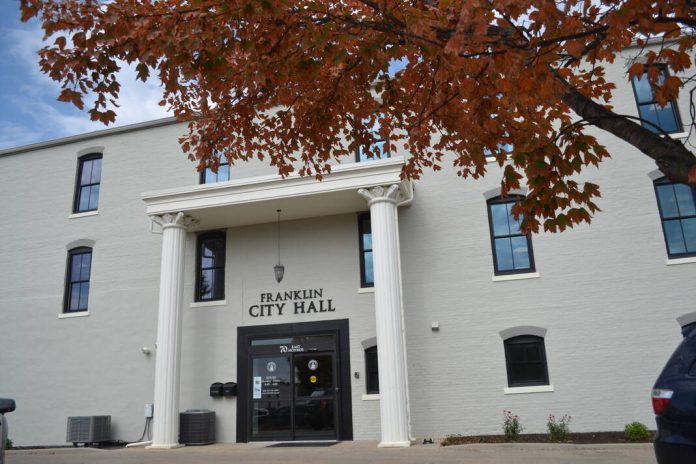Franklin’s largest businesses will have higher stormwater bills in 2024.
City Council members approved an ordinance establishing new rates that would use an ERU, or equivalent residential unit, system to charge based on the size of a business’s impervious surface instead of the city’s current flat fee system. Homeowners in the city will not see any change to their current $5 per month fee.
The new rates are based on recommendations from a study by Christopher B. Burke Engineering, of Indianapolis. The firm was hired to study how to best capture more revenue for the city’s stormwater utility without raising rates for homeowners.
The stormwater utility is responsible for inlet and pipe cleaning, ditch maintenance, stormwater pond maintenance, and the repair of all stormwater infrastructure, as well as sweeping city streets. The utility also maintains vehicles and equipment needed to maintain infrastructure and has administrative costs.
The new rate structure passed unanimously on Monday and will take effect on Jan. 1, 2024.
The rate structure
Currently, there is a flat fee of $5 per month for single-family residential, $2.50 per month for multifamily residential, $5 per month for non-residential properties equal to or less than 40,000 square feet and $15 per month for non-residential properties greater than 40,000 square feet, according to the rate study.
“That is insufficient to allow the city to really do any capital projects. It also severely limits any equipment the city can buy supporting the stormwater utility,” said Mark Richards, Franklin city engineer.
Under the new rate structure, businesses would pay based on an ERU, which is calculated based on the size of an average house. For Franklin, an ERU was determined to be 3,500 square feet. So, each business’s bill will be based on how many ERUs of impervious surface it has, which includes all buildings and parking lots on the property.
To come up with the fee, the utility would calculate how many ERUs of hard surface the property has and then multiply that by the residential rate of $5. This makes the business share equivalent to the homeowner’s share.
“The way we charged in the past would be like if an industrial sanitary sewer user that discharged millions of gallons a month (and) was paying the same or just a slightly higher rate than what a residential user was that was discharging 3,000 gallons,” Richards said.
An ERU funding formula is being used by about half of the communities that have a stormwater utility around the state, including most other Johnson County communities, the study shows. Even with the increase, the new rates will still be competitive with or lower than nearby communities, Richards said.

Why the increase?
The current rate structure leaves very little money to do anything outside of basic compliance with state law. The bulk of the money pays the city’s MS4 coordinator and his required inspections, with what little is left over going toward small stormwater projects, Richards said.
The 2015 stormwater master plan still has 10 outstanding projects due to the utility’s lack of revenue. The total cost of the master plan projects is estimated to be $16.2 million, while the current stormwater budget would only bring in $3 million over the next 10 years, the study says.
The utility has been underfunded since it began in 2009 under a state mandate. The initial goal was to put a utility in place because the state was requiring it, but it is now clear there is a need to raise money to offset the costs of stormwater projects in the growing city, officials said.
Several types of rate structures were considered, but the ERU-based system was deemed to be the best fit. It accomplishes the goals of raising revenue and making sure the largest users of the utility pay their fair share, Mayor Steve Barnett said.
“I know we always hear from taxpayers that when businesses get tax breaks, it doesn’t seem to be fair for the residents,” Barnett said earlier this month. “This is another one of those situations where we’re going to make it fair for the residents and make the businesses pay their share. We should have been doing this a long time ago.”
Implementation and reception
The rates for businesses will vary widely under the new rate structure. The largest ratepayer, Sunbeam Development Corporation, will pay $53,000 per year. Sunbeam is developing a group of warehouses and logistics buildings at Interstate 65. Other large ratepayers include the city itself, Johnson County and Franklin schools.
The city is giving Franklin schools a break on rates because several schools don’t discharge into the city’s stormwater system. Franklin schools will pay half of the normal business rate, effectively $2.50 per ERU instead of $5. Even with the discounted rate, the school system is still the second highest ratepayer at $35,000 per year, Richards said.
City officials reached out to a subset of the largest ratepayers to discuss the rate changes prior to the council’s vote Monday. Though business leaders were not happy about paying more, they understood why the increase was needed, Richards said. Since the increase doesn’t take effect for several months, ratepayers will have a few months to make room in their budgets to accommodate the rate increase.
The city council held a public hearing prior to voting for the rates, but no one from the public stepped forward to speak.
Large ratepayers aren’t necessarily stuck with their bills. They will have the opportunity to lower their bills by completing stormwater mitigation projects in exchange for bill credit, Richards said.
Information about the credit system and the entirety of the study is available online at franklin.in.gov/egov/documents/1691089254_46834.pdf.
With the rates in place, the city’s utility billing office will work with their vendor to update bills in time for the rate increase implementation next year.





